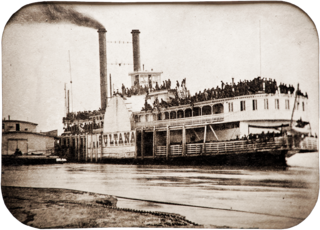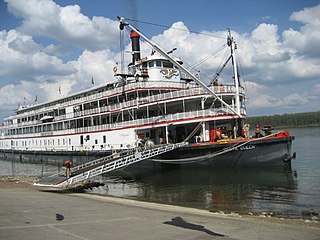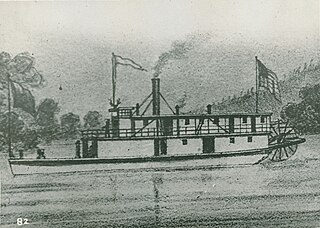
Sultana was a commercial side-wheel steamboat which exploded and sank on the Mississippi River on April 27, 1865, killing 1,167 people in what remains the worst maritime disaster in United States history.

The French freighter La Coubre exploded in the harbour of Havana, Cuba, on 4 March 1960 while it was unloading 76 tons of grenades and munitions. Seventy-five to 100 people were killed, and many were injured. Fidel Castro alleged it was an act of sabotage on the part of the United States, which denied any involvement.
Robert Louden, also known by the alias Charlie Dale, was a Confederate saboteur and mail carrier during the American Civil War. He was said to be the primary messenger between General Sterling Price and Confederate regulars and bushwhackers.
The explosion of the paddle steamer Saluda, near Lexington, Missouri, in 1852, was one of the worst disasters in Missouri River history.

Steamboats on the Columbia River system were wrecked for many reasons, including striking rocks or logs ("snags"), fire, boiler explosion, or puncture or crushing by ice. Sometimes boats could be salvaged, and sometimes not.

The steamboat Yosemite operated for almost fifty years on San Francisco Bay, the Sacramento River, inland coastal waters and the lower Fraser River in British Columbia, and Puget Sound.
The steamboat Pennsylvania was a side wheeler steamboat which suffered a boiler explosion in the Mississippi River and sank at Ship Island near Memphis, Tennessee, on June 13, 1858.

Gazelle was an early sidewheeler on the Willamette River in what is now the U.S. state of Oregon. She did not operate long, suffering a catastrophic boiler explosion on April 8, 1854, less than a month after her trial voyage. This was the worst such explosion ever to occur in the Pacific Northwest states. The wrecked Gazelle was rebuilt and operated for a few years, first briefly as the unpowered barge Sarah Hoyt and then, with boilers installed, as the steamer Señorita. A victim of the explosion was D.P. Fuller, age 28, who is buried in Lone Fir Cemetery in Portland, Oregon.

Steamboats played a major role in the 19th-century development of the Mississippi River and its tributaries, allowing practical large-scale transport of passengers and freight both up- and down-river. Using steam power, riverboats were developed during that time which could navigate in shallow waters as well as upriver against strong currents. After the development of railroads, passenger traffic gradually switched to this faster form of transportation, but steamboats continued to serve Mississippi River commerce into the early 20th century. A small number of steamboats are still used for tourist excursions in the 21st century.

The Lucy Walker steamboat disaster was an 1844 steamboat accident caused by the explosion of the boilers of the steamboat Lucy Walker near New Albany, Indiana, on the Ohio River. The explosion occurred on the afternoon of Wednesday, October 23, 1844, when the steamer's three boilers exploded, set the vessel on fire, and sank it. It was one of a number of similar accidents of early 19th-century riverine transportation that led to important federal legislation and safety regulations. The vessel's owner was a Native American; her crew were African-American slaves, and her passengers represented a cross-section of frontier travelers.

The river sternwheeler Ramona operated from 1892 to 1908 on the Willamette River in Oregon, on the Stikine River running from Wrangell, Alaska into British Columbia, and the Fraser River, in British Columbia. This vessel should not be confused with the coastal steamship Ramona which also ran in Alaskan waters.

Elk was a stern-wheel driven steamboat built on the Willamette River in 1857 at Canemah, Oregon. This steamboat is chiefly remembered for its destruction by a boiler explosion in which by good fortune no one was seriously hurt. A folklore tale later arose about this disaster.

The Moselle was a riverboat constructed at the Fulton shipyard, in Cincinnati, Ohio. between December 1, 1837 and March 31, 1838. The Moselle was considered one of the fastest river boats in operation at the time, having completed a record-setting two-day, sixteen-hour trip between Cincinnati and St. Louis. On April 25, 1838, the Moselle, piloted by Captain Isaac Perin, suffered a boiler explosion just east of Cincinnati, killing 160 of the estimated 280–300 passengers. The boat had just pulled away from a dock near the neighborhood of Fulton, when all four boilers simultaneously suffered a catastrophic failure resulting in the total destruction of the ship from the paddlewheels to the bow. The ship drifted approximately 100 yards before sinking to the bottom of the Ohio river. Negligence may have been a factor in the explosion: many eyewitness reports claimed that Captain Perin had been racing another riverboat, the Ben Franklin (1836) at the time of the explosion, and therefore the pressure in the boilers was excessively high.

James T. Staples, officially registered as the Jas. T. Staples and also known as the Big Jim, was a Tombigbee River sternwheel paddle steamer that ran a route between Mobile and Demopolis, Alabama, during the early 20th century. She was destroyed during 1913 in an explosion while docked on the Tombigbee roughly six miles (10 km) north of the current Coffeeville Lock and Dam. It was the last major maritime disaster involving a steamboat in Tombigbee River history. The disaster saw the ship enter southwestern Alabama folklore, with tales that its sinking had been foretold by supernatural occurrences.
The Lioness was a steamboat that exploded on the Red River of the South on the morning of May 19, 1833.

Wallamet was a sidewheel-driven steamboat that operated on the Willamette and Columbia rivers in Oregon and later on the Sacramento and San Joaquin rivers in California. Built in a Mississippi river style that was not suited to the conditions of these rivers, and suffering from construction defects, Wallamet was not a financially successful vessel. The name of this vessel is often seen spelled as Willamette.

Senator was a stern-wheel-driven steamboat which operated on the Willamette River in the state of Oregon from 1863 to 1875. Senator is chiefly remembered for its having been destroyed in a fatal boiler explosion in 1875 while making a landing at the Portland, Oregon waterfront in 1875.

The Anglo-Norman was a Mississippi River steamboat. The brand-new boat departed New Orleans on December 14, 1850, on a demonstration cruise but after a couple of hours on the water, as she turned around to head back to port, all her boilers exploded simultaneously. At least 100 people were killed. A newspaper writer who survived the explosion published an article about his experience entitled "The Experience of a Blown-up Man."
The SS Helen McGregor was an American steamboat. Her boilers exploded on February 24, 1830, in Memphis, Tennessee. The reported death toll ranged from 30 or 40 to 60. She had been docked at a wharf to pick up and discharge passengers; several of those killed were on the dock. More the 270 people had died various in steamship boiler explosions beginning in 1825; after the Helen McGregor the United States Congress asked "the secretary of the Treasury to investigate the boiler accidents."
The Mississippi River steamboat Princess was traveling from Vicksburg to New Orleans, with many of the passengers heading to Mardi Gras, when its boilers exploded at Conrad's Point near Baton Rouge, Louisiana on February 27, 1859. The estimated death toll ranged from 70 to as many as 200.














